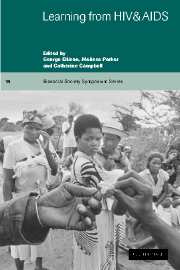Book contents
- Frontmatter
- Contents
- List of contributors
- Foreword by D. Clarke-Patel
- 1 Introduction. Learning from HIV and AIDS: from multidisciplinary to interdisciplinarity
- 2 HIV and the evolution of infectious diseases
- 3 The epidemiology of HIV/AIDS: contributions to infectious disease epidemiology
- 4 The influence of HIV/AIDS on demography and demographic research
- 5 What have clinicians learnt from working with HIV/AIDS? A medical perspective from London
- 6 How has the HIV/AIDS pandemic contributed to our understanding of behaviour change and health promotion?
- 7 Anthropological reflections on HIV prevention strategies: the case for targeting London's backrooms
- 8 An absence of anthropology: critical reflections on anthropology and AIDS policy and practice in Africa
- 9 A disaster with no name: the HIV/AIDS pandemic and the limits of governance
- 10 Postscript: reflections on HIV/AIDS and history
- Country index
- Subject index
- References
4 - The influence of HIV/AIDS on demography and demographic research
Published online by Cambridge University Press: 14 January 2010
- Frontmatter
- Contents
- List of contributors
- Foreword by D. Clarke-Patel
- 1 Introduction. Learning from HIV and AIDS: from multidisciplinary to interdisciplinarity
- 2 HIV and the evolution of infectious diseases
- 3 The epidemiology of HIV/AIDS: contributions to infectious disease epidemiology
- 4 The influence of HIV/AIDS on demography and demographic research
- 5 What have clinicians learnt from working with HIV/AIDS? A medical perspective from London
- 6 How has the HIV/AIDS pandemic contributed to our understanding of behaviour change and health promotion?
- 7 Anthropological reflections on HIV prevention strategies: the case for targeting London's backrooms
- 8 An absence of anthropology: critical reflections on anthropology and AIDS policy and practice in Africa
- 9 A disaster with no name: the HIV/AIDS pandemic and the limits of governance
- 10 Postscript: reflections on HIV/AIDS and history
- Country index
- Subject index
- References
Summary
Introduction
HIV and AIDS are having devastating effects on the demographic landscape particularly in sub-Saharan Africa (UNAIDS, 2002). Equally, recognition of the terrifying scale of the demographic impact of HIV epidemics has been crucial in the mobilisation of the –albeit still grossly inadequate – global response. Initially, the proposition that HIV epidemics had the potential, on their own, to reduce the high rates of population growth (3–4% per annum) seen in sub-Saharan African countries during the 1970s and 1980s to below zero within a time scale of two to three decades (Anderson et al., 1987) proved predictably controversial but awakened international and local concern at the possible severity of these epidemics. Subsequently, data directly linking positive HIV infection status to heightened mortality risk (Mulder et al., 1994) and verifying the enormous scale of the impact of HIV/AIDS on death rates in badly affected populations (Caraël and Schwartländer, 1998; UNAIDS, 2000) provided an empirical basis for, and thereby much-needed impetus to, efforts to control the pandemic.
In this chapter, we will see that HIV and AIDS are also leaving an indelible mark on the academic discipline of demography. The nature and scale of the effects of HIV/AIDS epidemics have been so profound that they have come to dominate the demographic agenda, particularly within Africa. As a consequence, new methods of study design, data collection, data analysis and demographic projection have been developed that reflect this new priority.
- Type
- Chapter
- Information
- Learning from HIV and AIDS , pp. 88 - 110Publisher: Cambridge University PressPrint publication year: 2003

